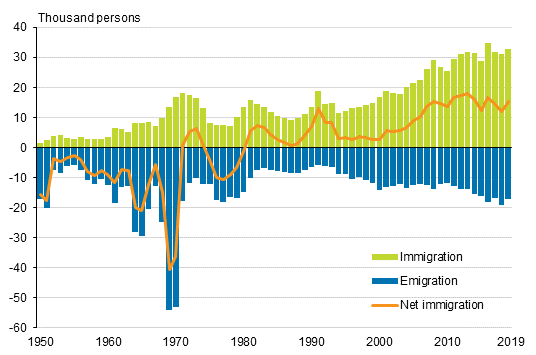News 16 Dec 2020
Statistical classic draws a picture of a changing Finland
The newly published Statistical Yearbook of Finland 2020 is a comprehensive volume of statistics that describes society and its development in Finland in detail.
In addition to the latest data, the Yearbook contains long time series and regional data, as well as plenty of comparison data on other countries. In addition to Statistics Finland’s statistics, the Yearbook also includes statistics by other producers of the Official Statistics of Finland. The book is in Finnish, Swedish and English and contains almost 600 pages and tables.
Extracts from the Statistical Yearbook of Finland
Immigration, emigration and net migration, 1950 to 2019

Data in Excel format (xlsx) (The chart in English in the third tab)
- At the end of 2019, Finland's population was 5,525,292. Of the population, 71 per cent were living in the area of the 50 biggest municipalities. Finland's population increased by 0.1 per cent from the year before. From 2014, the population has grown by one per cent.
- In 2019, a total of 17,263 persons moved abroad from Finland, of whom 65 per cent moved to EU countries. Most Finns moved to Sweden, from which the highest number of immigrants also came to Finland. A total of 32,758 immigrants arrived in Finland, of whom 40 per cent from EU countries. Net immigration was positive, in total 15,495 persons.
- Over one million internal moves took place within Finland last year: over one-half of them were intramunicipal migration and one-third intermunicipal migration. Migration between regions numbered 132,963. In 2019, migration gain from migration between regions was recorded by Uusimaa, Pirkanmaa and Southwest Finland.
- According to the Labour Force Survey, there were 2.6 million employed persons aged 15 to 74 in 2019, of whom 87 per cent were wage and salary earners and 13 per cent self-employed persons (incl. unpaid family workers). The number of unemployed aged 15 to 74 was 184,000, the unemployment rate was 6.7 per cent. The unemployment rate among young people was 17.2 per cent.
- Last year there were 26 unemployment funds and they had a total of 1.9 million members. During 2019, earnings-related allowance was paid to 245,508 members, which was 6.3 per cent lower than in the year before. A total of EUR 1,690 million was paid in earnings-related daily allowance. In 2019, basic daily allowance paid by the Social Insurance Institution was received by 65,444 persons, and it totalled EUR 210 million. The number of persons receiving labour market subsidy from the Social Insurance Institution was 282,227, and a total of EUR 1,659 million was paid.
- Of the employed wage and salary earners 67 per cent belonged to trade unions and 19 per cent only to an unemployment fund in 2019. Of young people aged 18 to 24, altogether 45 per cent were members of trade unions and unemployment funds, while in older age groups over 80 per cent of wage and salary earners were members.
- There are only minor changes in remote working of employed wage and salary earners between 2012 and 2019. The biggest change has taken place in respect of those who did not do remote work. Seventy-nine per cent of employed persons had not done remote work at all in the past 12 months in 2012, while 63 per cent of employees did not work remotely at all in 2019.
- There were a total of 1.6 million pensioners living in Finland at the end of 2019, which was 28 per cent of the entire population. In relative terms, the highest number of pensioners lived in South Savo, 39 per cent of the region's population.
- At the end of 2019, there were 56,926 pensioners living abroad, of whom 30,802 were Finnish citizens. The average monthly pension of those living abroad was EUR 422. The highest pensions were paid to those living in Portugal, EUR 3,110 per month, on average. The highest number of pensioners living abroad lived in Sweden.
- In 2019, victims of domestic violence and intimate partner violence numbered 10,546, of whom 7,335 were women and 3,211 men. One-third of the victims were women aged 25 to 44. There were more boys than girls among the victims aged under 10, while in the other age groups the share of women was higher than that of men.
- In all, 10.5 per cent of children aged 0 to 17 were living in households at risk of poverty in 2018. The at-risk-of-poverty threshold was EUR 14,970 per consumption unit. Examined by age group, one-quarter of those aged 18 to 24 were at risk of poverty.
Source: Statistical Yearbook of Finland 2020. Statistics Finland. Price EUR 80 (incl. VAT). The publication can be ordered from PunaMusta Oy’s online store and customer service +358 10 2308 365. The Yearbook can also be downloaded in PDF format at tilastokeskus.fi/vuosikirja2020.
Further information: Planner Sirkku Hiltunen tel. +358 29 551 6373
